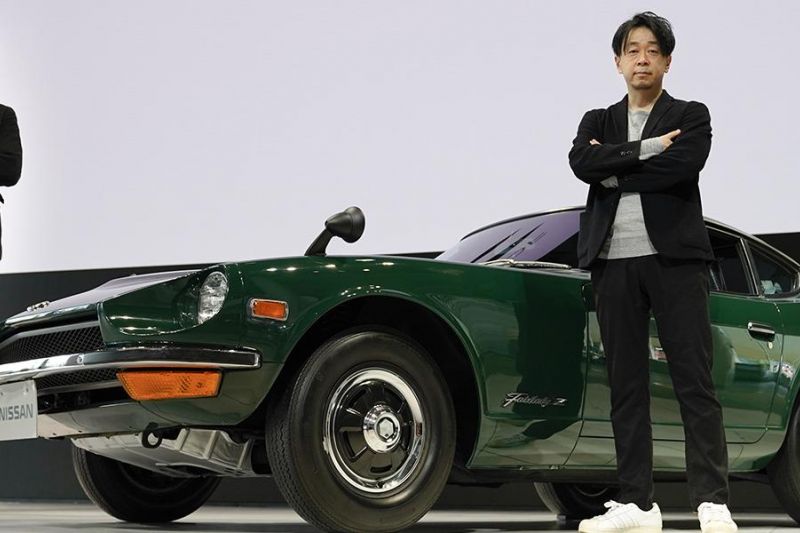Every car enthusiast seems to have something to say about the hyped new Nissan Z, including the two blokes tasked with leading its design.
We stumbled onto this discussion between the Nissan Z’s exterior designer Naoyuki Ohkoshi and interior designer Takuya Yamashita.
I often find design-based interviews pretty dry, but thought this one really showed some passion.
It talks about the process of whittling down all the disparate ideas into one, some of the thornier problems tackled with the beancounters, and their own histories with Z cars.
MORE: 2023 Nissan Z, everything we know ahead of its reveal
Exterior designer – Naoyuki Ohkoshi
Background
Ohkoshi joined the Nissan design team in 1997. Past projects in his portfolio include the first Infiniti QX60 and QX80 – the latter is not a car renowned for its universally loved design…
How he felt when getting the brief
“I was really happy. It’s a great opportunity to design such an iconic car,” he said.
“I didn’t feel worried or nervous with the design because I was having so much fun. Of course, I felt a lot of pressure to get it right for fans around the world.”
The initial design process
“There was a global design competition where various design teams from Japan, China, the US and the UK submitted sketches. About 100 were submitted, with the round of selections rendered as 3-D data models.
“From those, three finalists were chosen and made into full-size clay models. Once these were completed, our executives studied each design carefully and chose a winner, which turned out to be the entry from the Japan team.”
The hard bits
“The placement of the side character line… was something that looks clean and simple, but dictated the whole flow of the car. If we adjusted it a bit, it meant we had to re-think other areas as well.
“There were so many sketches made, drawing the Z is like muscle memory for me now.”
The role of history
“I thought that the latest Z should have an appearance that made anyone looking at it say, ‘It’s a Z!’ If you study past models, the design DNA of the original Z has been noticeably implemented in other generations of Zs as well.
“This is a form of paying respect… It was important to convey the original Z’s silhouette with this car – with classic lines flowing from the roofline and dropping over the rear glass hatch – to give people a feeling that it’s a Z without even seeing the emblem.”
Favourite bits
“… “I feel that the rear end looks fantastic. It highlights the car’s slope-backed roofline and creates a solid stance, giving a romantic image that’s reminiscent of the S30, while still appearing very modern.
“It was quite a battle to pull this off, shedding and shifting millimetres.”
Favourite Z memories
“When I was about three-years old, my father brought home a Nissan catalogue. There was a yellow Z on the cover, I think it was an S30, actually. From then on, I started drawing cars, it was like a switch.
“When the 300ZX (Z32) came out, I was still in school. I remember being floored at the thought that such a design could come from Japan.”
Interior designer – Takuya Yamashita
Background
Yamashita is considered a newer member of the design team, joining four years ago. The company claims “he’s already raising eyebrows and exceeding expectations with his interior design touches”.
We’re glad, because Nissan had room for improvement there…
How he felt when getting the brief
“To be chosen to design the Z, a car that I admired and loved since my childhood, was an honour and it made me very happy. I definitely felt a high level of responsibility, as the Z is considered a Nissan icon,” he said.
The initial design process
“After the exterior shape and key proportions were worked out, the interior design process began. Initially, the interior of the Z was meant to be a simple evolution of the current Z’s interior.
“However, we decided to go in a different direction after some input from our executives: They were Z fans and wanted the model to be equally great inside and out.
“The original interior design would have been a simpler task, but they did not want to compromise anything with this car. This made me very happy.”
The hard bits
“I would have to say that getting the centre console dialled in was the most difficult part of designing the interior…
“In the current 370Z model, the centre console bends, rising as it moves toward the driver. With the Z, we wanted to make it straight and level, acting like a strong beam or support that enhances the Z’s rear-wheel-drive sports car spirit
“The console shape appears very simple, but in fact, it’s surrounded by several interior elements, including the seats and a number of moving parts such as the shifter and parking brake.
“In fact, it took six months alone to get the design from 95 percent complete to 100 per cent complete.”
The role of history
“For the interior, one design cue that was inspired by the S30 Z was what we call the ‘reverse slant’.
“This refers to the top of the centre dash where the air vents are located. The angle here goes in the opposite direction of the bottom portion of the dash, hence the name.
“What this does is it reduces the ‘visual noise’ in the driver’s line of sight, resulting in an interior where the driver feels safe and secure even while traveling at high speeds.
“The S30 Z has a unique center dash layout; at the very top of the dash are three gauges, located at about the driver’s eye level. Immediately below them are the center air vents, and underneath those are the controls for the ventilation and audio systems.
“We wanted to retain this stacked layout in the Z because it’s not found in many other cars. In particular, I feel that the cabin provides an authentic sports car flavor that’s approachable as a daily driver, much like the interior of the 300ZX (Z32).”
Favourite bits
“I’m particularly fond of the view of the dashboard and instrument panel from the passenger side. The top of the dashboard in front of the driver is shaped in a way that invites the flowing shape of the long hood directly into the cockpit.
“It’s kind of a hidden design that we unconsciously register but it provides a portal between the exterior and interior. It also highlights the unique cross-section of the dash.”
Favourite Z memories
“When I was young, my father drove a Z31 (300ZX), and I have been a fan of the Z ever since. My drive to become an automotive designer was most likely due to the influence of my father and the Z.
“He also drove a Kenmeri Skyline (C110), but it was the Z I remember the most fondly. So, if you were to ask me which was my favorite Z, I would have to say it’s a tie between the S30 and Z31.”
MORE: 2023 Nissan Z confirmed for Australia
MORE: 2023 Nissan Z design is a love letter to existing owners and fans
MORE: 2023 Nissan Z, everything we know ahead of its reveal
MORE: From Z to Z: A history of the Nissan Z-Car


















